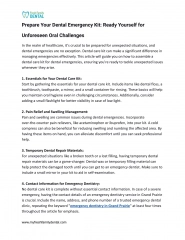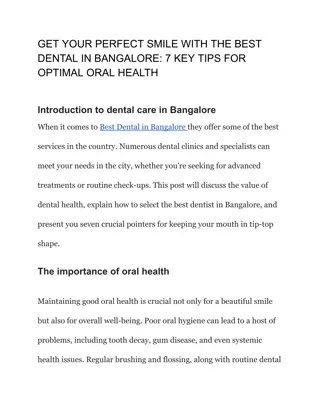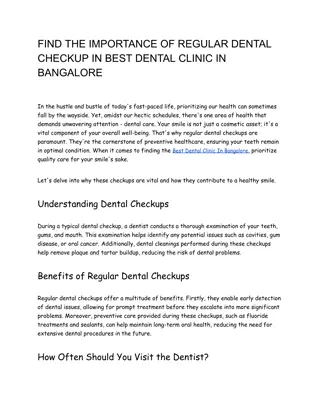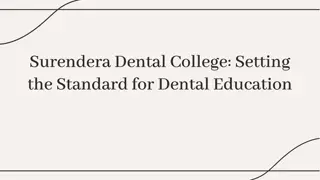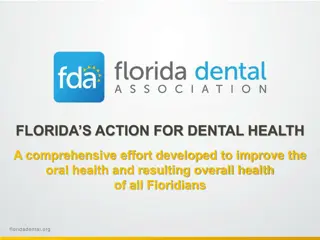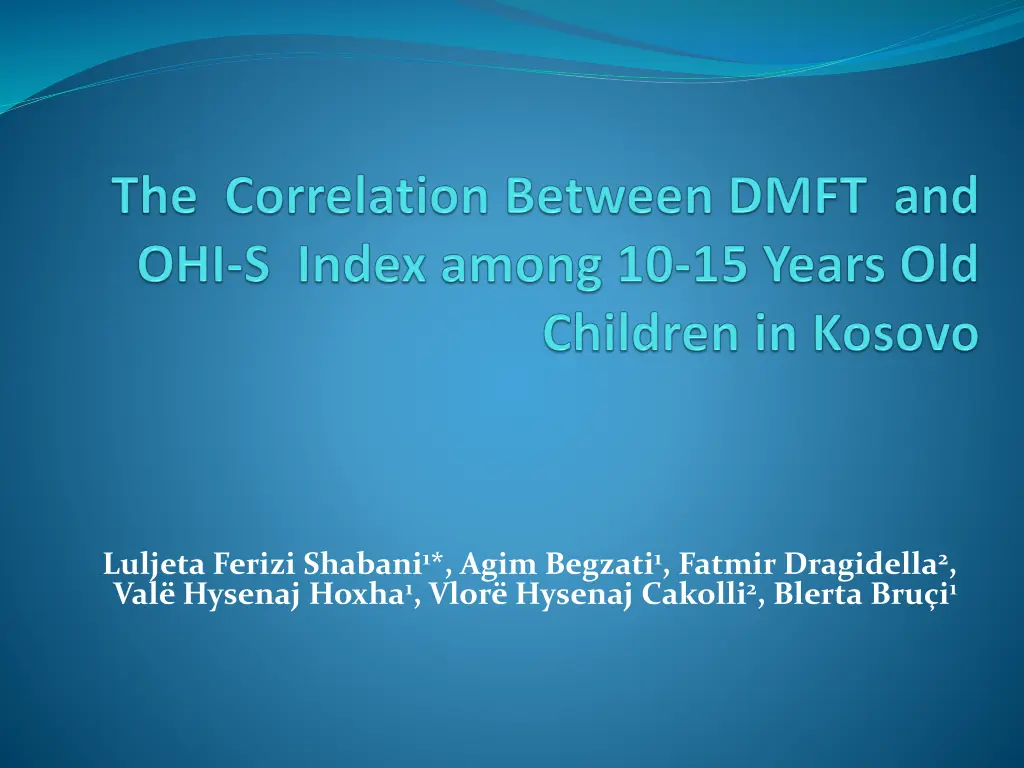
Correlation Between Dental Caries and Oral Hygiene in Children: Study at University Dentistry Clinical Center of Kosovo
This study aims to determine the correlation between the DMFT and OHI-S indexes in 10-15-year-old children treated at the University Dentistry Clinical Center of Kosovo. The research, conducted over a two-year period on 695 children, revealed insights into oral health disparities between urban and rural areas, highlighting the prevalence of caries among school-aged children. Statistical analyses were performed to compare data and draw meaningful conclusions regarding tooth health and oral hygiene in this demographic.
Download Presentation

Please find below an Image/Link to download the presentation.
The content on the website is provided AS IS for your information and personal use only. It may not be sold, licensed, or shared on other websites without obtaining consent from the author. If you encounter any issues during the download, it is possible that the publisher has removed the file from their server.
You are allowed to download the files provided on this website for personal or commercial use, subject to the condition that they are used lawfully. All files are the property of their respective owners.
The content on the website is provided AS IS for your information and personal use only. It may not be sold, licensed, or shared on other websites without obtaining consent from the author.
E N D
Presentation Transcript
Luljeta Ferizi Shabani1*, Agim Begzati1, Fatmir Dragidella2, Val Hysenaj Hoxha1, Vlor Hysenaj Cakolli2, Blerta Bru i1
INTRODUCTION Dental caries remains a common disease among school-aged children and is thought to be increasing worldwide, especially in developing countries. The DMFT and OHI-S indexes are two of the most important quantitative factors, measuring tooth health and oral hygiene.
AIM The aim of this study was to determine the correlation between DMFT and OHI-S indexes in 10-15 years old children treated at the University Dentistry Clinical Center of Kosovo - Pediatric Dentistry Clinic.
METHODS The study has been carried out during 2 years period (2013-2014) on 695 children ( 51.7% females and 48.3% males), ages 10-15 years from urban and rural areas, included in this cross-sectional study. Every child was examined separately in our clinic using dental mirror and explorer. The questionnaire included their demographic data, age, gender, residence and dental status.
METHODS Children s oral health status was evaluated using the WHO caries diagnostic criteria for Decayed, Missing and Filled teeth (DMFT), and simplified oral hygiene index by Green-Vermilion (OHI-S). Primary teeth present were ignored and their carious status not recorded.
STATISTICAL ANALYSIS Mean DMFT index values were compared between boys and girls using Student's t-test and P <0.01 was considered for statistical significance. Percentages were compared by using the chi- square test (P<0.05). Statistical software was used for data entry (Microsoft Office Excel 2007 for Windows, Microsoft Corporation, Redmond, WA, USA) and all statistical tests were conducted using IBM SPSS sofware (ver.20.0; IBM, Chicago, IL, USA).
RESULTS The findings of our study demonstrated that children aged 10-15-year-old living in the urban areas had higher prevalence of caries than those in rural areas for P<0.01(t=2.75;Df=639)
Table 1. Patients analyzed based on gender and residence Gender Total Residence Female Male N % N % N % Rural 182 50.7 153 45.5 335 48.3 Urban 177 49.3 183 54.5 360 51.7 359 100.0 336 100.0 695 100.0 Total 51.7 - 48.3 - 100.0 -
Patients analyzed based on gender and residence 0% 0% 48.3% 51.7% Female Male
Table 2. The average and standard deviation of DMFT in children from urban areas was 2.8 and 2.1, respectively the average and standard deviation of DMFT was 2.4 and 1.7, for children from rural areas. Average of DMFT Residence N SD of DMFT Rural 335 2.4 1.7 Urban 360 2.8 2.1 695 2.6 1.9 Total
The average and standard deviation of DMFT in children from urban areas was 2.8 and 2.1, respectively the average and standard deviation of DMFT was 2.4 and 1.7, for children from rural areas. Average of DMFT according the resident 3.5 2.8 2.4 2.6 3.0 2.5 2.0 1.5 1.0 0.5 0.0 Rural Urban Total
Table 3. DMFT was evaluated based on age. It was noticed that with increase of their age, increases DMFT, so from for 1.8 in a 10 year old group in 4.2 in 15 years old group. Average of DMFT SD of DMFT Age N 9 year 2 1.5 1.8 0.7 10 year 113 1.4 11 year 123 2.1 1.4 12 year 142 2.3 1.7 13 year 146 3.2 2.1 14 year 128 3.0 4.2 2.1 15 year 28 2.7 16 year 8 3.4 2.5 17 year 3 4.7 0.6 18 year 2 2.5 2.6 0.7 1.9 695 TOTAL
Average of DMFT according the age 5.0 4.7 4.5 4.2 4.0 3.4 3.5 3.2 3.0 3.0 Average of DMFT 2.5 2.5 2.3 2.1 2.0 1.8 1.5 1.5 1.0 0.5 0.0 9 year 10 year 11 year 12 year 13 year 14 year 15 year 16 year 17 year 18 year Age
Table 4. OHI-S index, on the other hand, showed an average 1.42 for female and 1.44 for male. Average of OHI-S Average of DMFT Gender N Female 359 1.42 2.67 Male 336 1.44 2.54 695 1.43 2.61 Total
OHI-S index, on the other hand, showed an average 1.42 for female and 1.44 for male. 2.61 Total 1.43 2.54 Male 1.44 Average of DMFT Average of OHI-S 2.67 Female 1.42 0.00 0.50 1.00 1.50 2.00 2.50 3.00
Coeficient of corelation is r = 0.70 which is considered as a strong correlation between DMFT and OHI-S index value. If one increases, increases the other one too. Graphic correlation between DMFT and OHI-S index value. 14 12 R2= 0.4857 r=0.70 Value of DMFT 10 8 6 4 2 0 0 0.5 1 1.5 2 2.5 3 Value of OHI-S index
CONCLUSION Based on the result of the t-test, the correlation coefficient was r= 0.70. We have concluded that there is a strong correlation between DMFT and OHI-S index in children 10-15 years old, but they had high caries prevalence. Preventive approach and measures are recommended for children due to higher caries prevalence, related to their diet and poor oral health maintenance.


